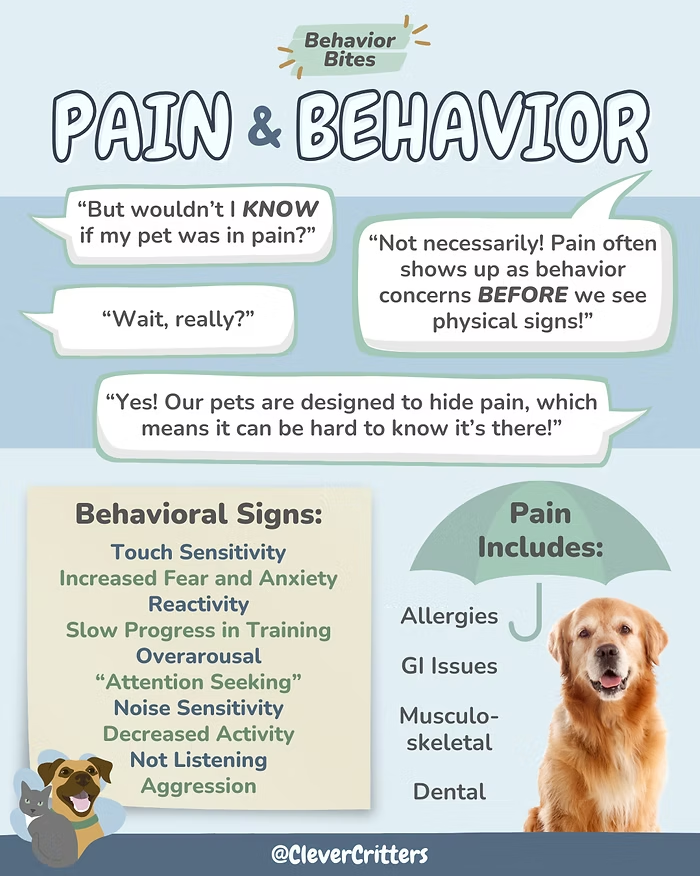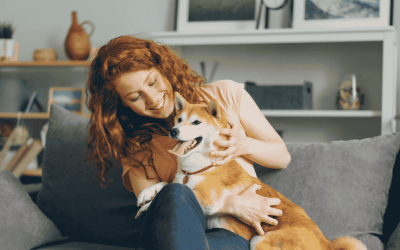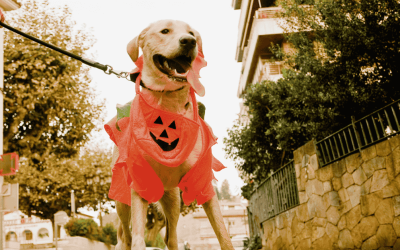After decades of caring for and working with dogs and their families, one of the most important lessons I’ve learned is this: behavior is communication. What appears to be a problem behavior on the surface often has a deeper underlying cause. Families call us regularly about house training setbacks, sudden anxiety, restless pacing, barking and lunging on walks, etc. But when we slow down, ask questions, and look closer, we often discover that the dog isn’t reactive, misbehaving, or being needy. Rather, the dog is hurting. Let’s discuss when bad behavior is really pain.
“Misbehaving” As a Sign
Inappropriate Elimination
A dog that suddenly urinates indoors after years of reliability could have a urinary tract infection, crystals in their bladder, incontinence, or the beginning stages of cognitive decline, making it hard for them to get outside quickly enough, control their bladders, or even recognize the need to urinate.
Disruptive Behaviors
Similarly, a dog that suddenly starts pacing at night is sure to disrupt their family’s sleep, but it may be due to undiagnosed joint pain, neurological discomfort, and other signs of aging or medical conditions that make lying down, resting, and sleeping difficult.
Separation Anxiety
Separation anxiety that seems to appear “out of nowhere” can sometimes be traced back to discomfort. Our dogs know that we represent survival. When we’re not there, the comfort of human presence fades away, and fear of not having adequate resources may cause agitation. Do they miss us? Sure, but the reason they may display unusual, destructive, or concerning behaviors may have more to do with a medical need that is not being met than our departure.
Reactivity
A dog’s sudden change in behavior around other dogs, unfamiliar people, and new experiences can also be a telltale sign of physical discomfort. A painful dog is more prone to snapping, being defensive, or trying to create space from a perceived threat by retreating or hiding. Sure, some dogs have profound wounds that make them reactive or aggressive in certain situations, but a dog that seems to suddenly develop reactivity on a walk, for example, may be signaling fear caused by pain.
Discerning a Dog’s Behavior
As a professional dog walker and pet sitter, I view my role as a piece of the larger support team for each of the pets in our care. Our dog walking and pet sitting services provide exercise, enrichment, and routine, but before I take on a new client with concerns like those above, I always ask the following questions:
-
When did the behavior start?
-
Have you consulted your veterinarian?
These questions are not meant to worry families, but to protect everyone involved, most importantly, the dog. We don’t want to focus on harness recommendations, walking routines, and positive reinforcement training if what the dog truly needs is medical attention. These tools are great for healthy dogs, but we cannot positively reinforce a sick dog into well-being. Painful, sick, and otherwise uncomfortable dogs need veterinary care!
When “Bad Behavior” Is Really Pain
Too often, we interpret our dogs’ behaviors through a human lens. We see a dog that needs more training, a “naughty dog”, or even a “bad dog”, which, of course, breaks my heart. Yet, experts agree that a dog’s behavior reflects one of the following three things:
-
Their physical comfort
-
Their emotional state
-
Their understanding (or lack thereof) of our instructions
This is why collaboration is key. If a new client shares that their dog is suddenly destructive, anxious, or reactive, my first response isn’t a quick fix but an open, supportive conversation. Have they had a recent vet exam? Could this be mobility-related? Could pain be contributing? Only veterinary care can reveal the true source of the struggle, which is why a consultation with your vet should be the first step when your dog’s behavior suddenly changes.
When Veterinarians Give the Okay
Of course, once a health concern is ruled out or addressed, that’s when walking and pet sitting visits truly shine. Exercise builds strength, relieves stress, and supports recovery. Routine gives anxious and bored dogs a sense of safety and purpose. Compassion and patience ensure every dog in our care feels seen, heard, and loved.
At the end of the day, I never want to “walk off” a deeper problem. My responsibility is to listen, observe, and advocate for the dogs entrusted to our care. And often, the bravest thing we can do as professionals is to say: Get the veterinary piece checked first. Only then can we give our dogs what they really need.





0 Comments